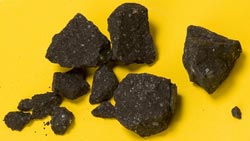

Scientists led by Sandra Pizzarello, a research professor in ASU's Department of Chemistry and Biochemistry, found that the Sutter’s Mill meteorite, which exploded in a blazing fireball over California last year, contains organic molecules not previously found in any meteorites.
These findings suggest a far greater availability of extraterrestrial organic molecules than previously thought possible, an inventory that could indeed have been important in molecular evolution and life itself.
The work is being published in this week’s Proceedings of the National Academy of Sciences http://dx.doi.org/10.1073/pnas.1309113110; 2013. The paper is titled “Processing of meteoritic organic materials as a possible analog of early molecular evolution in planetary environments,” and is co-authored by Pizzarello, geologist Lynda Williams, NMR specialist Gregory Holland and graduate student Stephen Davidowski, all from ASU.
Coincidentally, Sutter’s Mill is also the gold discovery site that led to the 1849 California Gold Rush. Detection of the falling meteor by Doppler weather radar allowed for rapid recovery so that scientists could study for the first time a primitive meteorite with little exposure to the elements, providing the most pristine look yet at the surface of primitive asteroids.
“The analyses of meteorites never cease to surprise you … and make you wonder,” explains Pizzarello. “This is a meteorite whose organics had been found altered by heat and of little appeal for bio- or prebiotic chemistry, yet the very Solar System processes that lead to its alteration seem also to have brought about novel and complex molecules of definite prebiotic interest such as polyethers.”
Pizzarello and her team hydrothermally treated fragments of the meteorite and then detected the compounds released by gas chromatography-mass spectrometry. The hydrothermal conditions of the experiments, which also mimic early Earth settings (a proximity to volcanic activity and impact craters), released a complex mixture of oxygen-rich compounds, the probable result of oxidative processes that occurred in the parent body. They include a variety of long chain linear and branched polyethers, whose number is quite bewildering.
This addition to the inventory of organic compounds produced in extraterrestrial environments furthers the discourse of whether their delivery to the early Earth by comets and meteorites might have aided the molecular evolution that preceded the origins of life.
Jenny Green, jenny.green@asu.edu
480-965-1430
Department of Chemistry and Biochemistry












